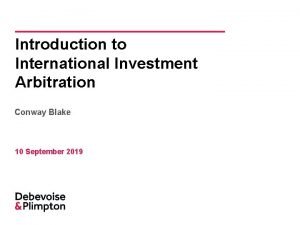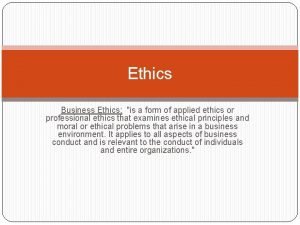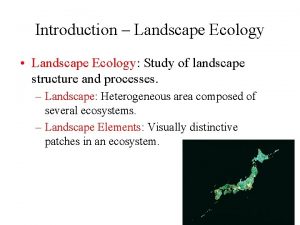Conway School of Landscape Design The mission of




- Slides: 4

Conway School of Landscape Design The mission of the Conway School of Landscape Design is to explore, develop, practice, and teach design of the land that is ecologically and socially sustainable. Ø Intensive 10 -month graduate program of applied study in an integrated format: core courses related directly to residential and community projects Ø Emphasis is on ecologically and socially sustainable design of the land, integrated communication skills, individual educational goals, learning through real projects at a range of scales Ø Intentionally small in size (19 students maximum) with high faculty to student ratio (three core faculty, two adjuncts and more than 50 guest workshop leaders, lecturers and visiting teachers each year). Ø Offers a Master of Arts in Landscape Design, authorized by the Massachusetts Council of Higher Education and accredited by the New England Association of Schools and Colleges, Inc.

What makes Conway unique? q REGENERATIVE DESIGN — We work together to discover what sustainability can mean to a project and to the planet and then go beyond that to discover opportunities for restoring, reclaiming, and regenerating degraded places and communities; q REAL-WORLD PROJECTS — from the start of each term students manage their own real projects with real clients, learning by doing; q CAREFULLY INTEGRATED LEARNING — classes, studio time, field trips, and guest speakers are organized around the projects for that term, rather than around separate courses on separate topics; q WHOLE AND COMPLEX UNDERSTANDING OF NATURAL AND CULTURAL SYSTEMS — inter-relationships across scales are examined, no matter the project scope; q DIVERSE, INNOVATIVE TEACHING FORMATS — in appreciation of individual learning styles and interests, we help each student define educational goals and a career path; much instruction is in small groups or one-on-one; q COLLABORATION, NOT COMPETITION — each student or team of students has its own project, and everyone shares the goal of learning about design that is ecologically and socially sensitive through all of the projects being undertaken that term; q A HUMANITIES PERSPECTIVE — We explore the roles of values, ethics, and meaning in landscape design and offer practical training in oral and written communication skills, which are integrated throughout the year; and q FULL INTEGRATION INTO ITS LANDSCAPE IN SCENIC NEW ENGLAND — activities take advantage of our setting, with many classes taking place in the field, learning about the complex functions of water, soil, plants and climate. q RICH LEARNING COMMUNITY – Students are from diverse backgrounds, encompass a wide age range, and bring multiple interests in sustainable design; they graduate into as broad a spectrum of professional careers in landscape architecture, local and regional planning, environmental restoration, and ecological design.

What does it take to start a school? 10 steps to the Olmsted School of Land Design 1. Establish a “Friends of the Olmsted School of Land Design” – draft the mission statement and general curricular focus 2. Identify a working board of School Advisors and identify a Board of Trustees 3. Interview and hire the core staff: Administrative Director, Academic Director, Administrative Assistant 4. Revise/delineate a curriculum outline: its level, emphasis, program length, educational operations 5. Select, plan and construct the facilities; purchase equipment

What does it take to start a school? 10 steps, continued 6. Conduct short classes to test curriculum: weekend workshops and summer programs to build faculty skills and to generate student interest 7. Secure the appropriate authority for non-profit, degreegranting status and establish the basis for eventual accreditation 8. Launch the first year program with a limited number of students 9. Conduct post-operative testing of the first year program and the deliverables 10. Continue to monitor, evaluate, upgrade and expand







